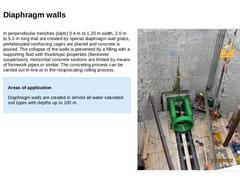
|

In perpendicular trenches (slats) 0.4 m to 1.20 m width, 2.0 m to 5.0 m long that are created by special diaphragm wall grabs, prefabricated reinforcing cages are placed and concrete is poured. The collapse of the walls is prevented by a filling with a supporting fluid with thixotropic properties (Bentonite suspension). Horizontal concrete sections are limited by means of formwork pipes or similar. The concreting process can be carried out in-line … |

|

(Image: Construction of the baffle wall (reinforced concrete) on both sides of the slot for the diaphragm wall excavator) (Image: Completed baffle wall for the diaphragm wall excavator) (Image: Excavation of the diaphragm wall - Diaphragm wall excavator) (Image: Detail of diaphragm exhibitor) (Image: Reinforcement cages for the diaphragm wall) (Image: Concreting the diaphragm wall) (Image: Chipping of the top of the baffle and diaphragm wall, exposing … |
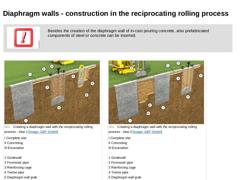
|

|
(Image: Attention!)
Besides the creation of the diaphragm wall of in-cast pouring concrete, also prefabricated components of steel or concrete can be inserted. |
|
|
|
(Image: Creating a diaphragm wall with the reciprocating rolling process - step 1) |
(Image: Creating a diaphragm wall with the reciprocating rolling process - step 2) |
|
(Video: Excavator in diaphragm wall operation) |
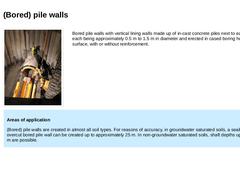
|

(Image: Starting shaft with bored pile wall) Bored pile walls with vertical lining walls made up of in-cast concrete piles next to each other, each being approximately 0.5 m to 1.5 m in diameter and erected in cased boring holes from the surface, with or without reinforcement. |
|
Areas of application (Bored) pile walls are created in almost all soil types. For reasons of accuracy, in groundwater saturated soils, a sealing overcut bored pile wall can be … |
|
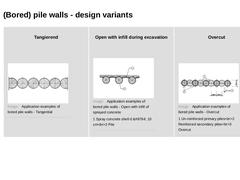
|

|
Tangierend
(Image: Application examples of bored pile walls - Tangential) |
Open with infill during excavation
(Image: Application examples of bored pile walls - Open with infill of sprayed concrete) |
Overcut
(Image: Application examples of bored pile walls - Overcut) |
|
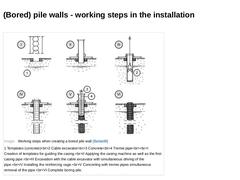
|

(Image: Working steps when creating a bored pile wall [Balda88]) |
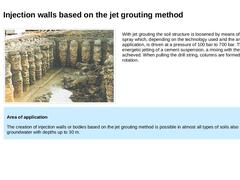
|

| (Image: Open columns during excavation [FI-Brück]) | With jet grouting the soil structure is loosened by means of a jet spray which, depending on the technology used and the areas of application, is driven at a pressure of 100 bar to 700 bar. Through the energetic jetting of a cement suspension, a mixing with the soil is achieved. When pulling the drill string, columns are formed due to the rotation. | Area of application The creation of injection walls … |
|

|

(Image: Working steps when creating an injection wall (column row) [FI-Keller]) |

|

(Image: Application of the spray concrete) (Image: Application of the spray concrete) (Image: View into the starting shaft with spray concrete support - Extension of the exhavation) (Image: View into the starting shaft with spray concrete support - Making of the entry opening) Securing surfaces with sprayed concrete can be carried out as necessary as a thin sealing layer, as a structural, reinforced sprayed concrete coat of little thickness or as a … |
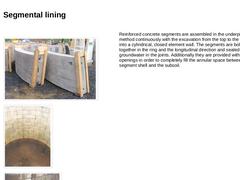
|

|
(Image: Segments) (Image: Shaft with view of the unfinished shaft base [FI-Charc]) (Image: Installing a segment in the underpinning method [FI-Charc]) |
Reinforced concrete segments are assembled in the underpinning method continuously with the excavation from the top to the bottom into a cylindrical, closed element wall. The segments are bolted together in the ring and the longitudinal direction and sealed against groundwater in the joints. Additionally … |
|
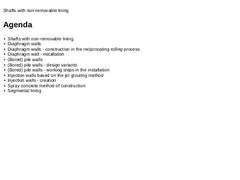
|

|
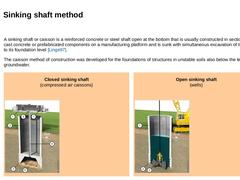
|

A sinking shaft or caisson is a reinforced concrete or steel shaft open at the bottom that is usually constructed in sections of in-cast concrete or prefabricated components on a manufacturing platform and is sunk with simultaneous excavation of the core to its foundation level [Linge97]. The caisson method of construction was developed for the foundations of structures in unstable soils also below the level of the groundwater. |
|
Closed sinking shaft |
|
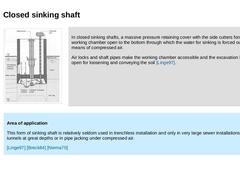
|

|
(Image: Closed sinking shaft during building the 26 m deep starting shaft (dimensions 7.5 m x 14 m) for the utility tunnel "Energieversorgungstunnel Kieler Förde" (Bild 9.2.1.3.1) (Bild 9.2.1.3.1) (Bild 2.2.4) [Holzm93b]) |
In closed sinking shafts, a massive pressure retaining cover with the side cutters forms a working chamber open to the bottom through which the water for sinking is forced out by means of compressed air. Air locks and shaft pipes … |
|
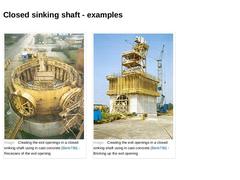
|

(Image: Creating the exit openings in a closed sinking shaft using in cast concrete [Biele79b] - Recesses of the exit opening) (Image: Creating the exit openings in a closed sinking shaft using in cast concrete [Biele79b] - Bricking up the exit opening) |
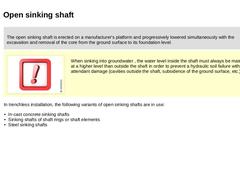
|

|
The open sinking shaft is erected on a manufacturer's platform and progressively lowered simultaneously with the excavation and removal of the core from the ground surface to its foundation level. | | | (Image: Attention!)
When sinking into groundwater , the water level inside the shaft must always be maintained at a higher level than outside the shaft in order to prevent a hydraulic soil failure with its attendant damage (cavities outside the shaft, … |
|
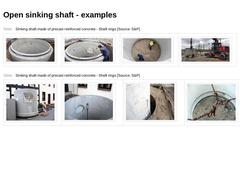
|

(Table: Sinking shaft made of precast reinforced concrete - Shaft rings) (Table: Sinking shaft made of precast reinforced concrete - Shaft rings) |
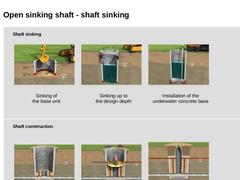
|

|
Shaft sinking
|
(Image: Construction phases of the trenchless installation of sewers on the model of microtunnelling - Phase 1 (Sinking of the shaft): Sinking of the base unit of the shaft) |
|
Sinking of
the base unit |
|
|
(Image: Construction phases of the trenchless installation of sewers on the model of microtunnelling - Phase 1 (Sinking of the shaft): Sinking up to the design depth) |
|
Sinking up to
the design depth |
|
|
(Image: Construction phases of … |
|
|
|
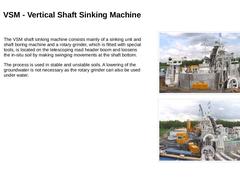
|

The VSM shaft sinking machine consists mainly of a sinking unit and shaft boring machine and a rotary grinder, which is fitted with special tools, is located on the telescoping road header boom and loosens the in-situ soil by making swinging movements at the shaft bottom. The process is used in stable and unstable soils. A lowering of the groundwater is not necessary as the rotary grinder can also be used under water. |
|
(Image: VSM shaft sinking … |
|
|
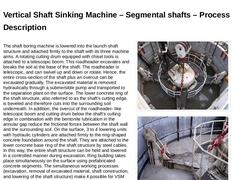
|

The shaft boring machine is lowered into the launch shaft structure and attached firmly to the shaft with its three machine arms. A rotating cutting drum equipped with chisel tools is attached to a telescopic boom. This roadheader excavates and breaks the soil at the base of the shaft. The roadheader is telescopic, and can swivel up and down or rotate. Hence, the entire cross-section of the shaft plus an overcut can be excavated gradually. The excavated … |

|

| (Image: Pros and cons) | | Advantages of open sinking shafts: - Technically simple method of construction especially in unstable subsoil
- High economic efficiency (reduction of the fixed costs of the site equipment, the utilization as a final lining)
| | Disadvantages of open sinking shafts: - In groundwater, drying out the excavation base is only possible by using additional measures
- The control of the soil during excavation and the removal of obstacles (boulders …
|
|
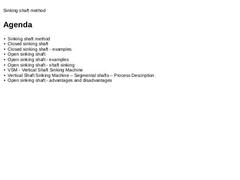
|

|
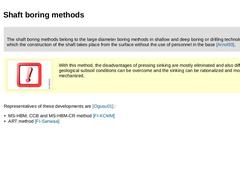
|

The shaft boring methods belong to the large diameter boring methods in shallow and deep boring or drilling technology in which the construction of the shaft takes place from the surface without the use of personnel in the base [Arnol93]. |
|
|
|
(Image: Attention!)
With this method, the disadvantages of pressing sinking are mostly eliminated and also difficult geological subsoil conditions can be overcome and the sinking can be rationalized and mostly … |
|
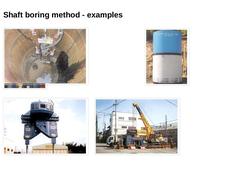
|

(Image: CCB method: shaft boring method with reinforced concrete upper shaft rings for use in soil [FI-KCMM] - Inserting the core boring crown with torsion resisting connected reinforced concrete shaft rings in the rotary table) (Image: CCB method: shaft boring method with reinforced concrete upper shaft rings for use in soil [FI-KCMM] - Reinforced concrete shaft ring with removable steel upper shaft ring placed on top) (Image: MS-HBM-CR method (… |

|

|
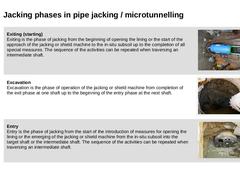
|

|
(Image: View into the starting pit - Positioning of the pipe jacking machine in the entry opening)
Exiting (starting)
Exiting is the phase of jacking from the beginning of opening the lining or the start of the approach of the jacking or shield machine to the in-situ subsoil up to the completion of all special measures. The sequence of the activities can be repeated when traversing an intermediate shaft. |
|
(Image: Wear when using a shield machine … |
|